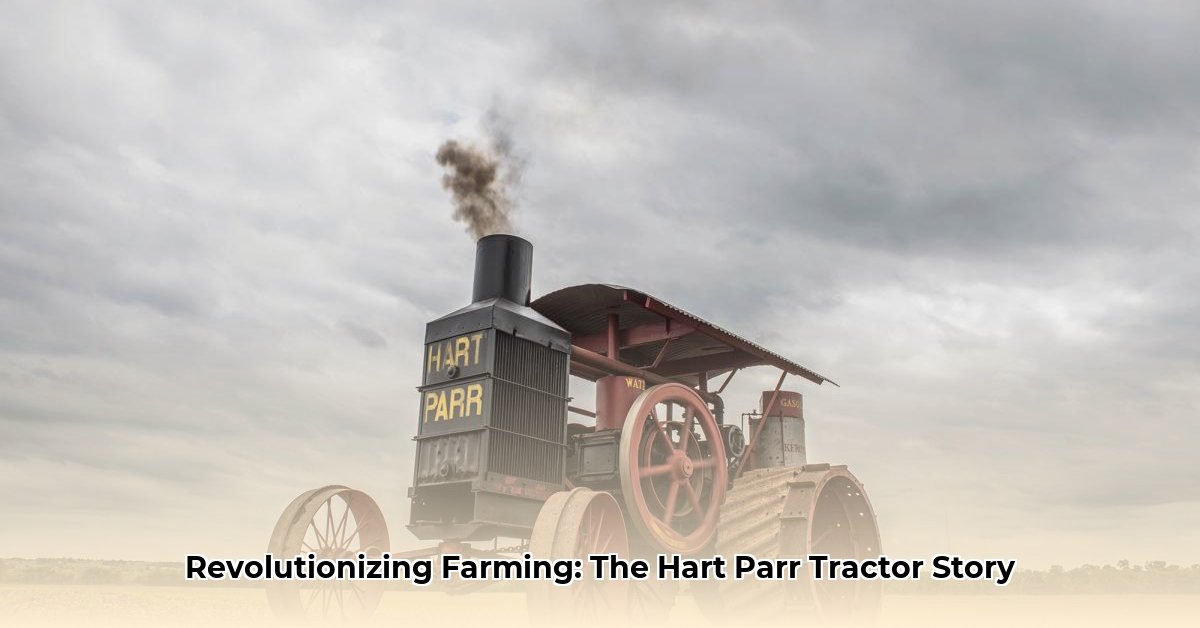
Hart Parr Tractor: A Revolution in the Fields
Long before the sleek, high-tech tractors of today, there was Hart-Parr. This isn't merely a tale of antiquated farm equipment; it's the story of Charles Hart and Charles Parr, two men who fundamentally altered the way we cultivate food. Their journey, from rudimentary early models to the legendary innovations that defined Hart-Parr, is a captivating blend of history, invention, and ingenious mechanics. This article explores their transformative impact, easily understandable whether you're a farming expert or simply curious about the past. For another perspective on early tractor innovation, see this article on early Ford tractors: early Ford tractors.
Did you know that before the early 1900s, farming was overwhelmingly reliant on manual labor and animal power? This incredibly arduous task, fraught with physical strain and susceptibility to unpredictable weather patterns, left efficiency a distant dream. This stark reality is precisely what drove Charles Hart and Charles Parr to envision a better, more mechanized future.
From "Old Number One" to a Farming Revolution
Their journey began in 1901 with "Old Number One," their first successful gasoline tractor. This wasn't a mere prototype; it was a functional machine, ready for the rigors of farm work. While many farmers, deeply rooted in tradition, harbored skepticism – viewing horses as reliable and the newfangled gasoline contraption as a potential disaster – Hart and Parr pressed onward, driven by their belief in a groundbreaking innovation.
Their early tractors were not only powerful but also brilliantly engineered. The pioneering valve-in-head engine, previously unseen in agricultural machinery, was coupled with an innovative oil-cooling system—critical for engine reliability in harsh conditions. They cleverly utilized readily-available kerosene as an alternative fuel, enhancing practicality and cost-effectiveness for farmers. Their focus wasn't just on power; it was on designing a machine farmers could depend on.
The transition from stationary to self-propelled tractors presented immense challenges. They had to engineer a mobile power source capable of handling heavy plows over often uneven terrain. The Hart-Parr design elegantly solved these problems, establishing a new benchmark in agricultural mechanization. How did they manage such a feat of engineering? The answer lies in their dedication to practical, user-focused design.
The Impact Ripples Through Time
The initial reception wasn't overwhelming, but as word spread of the Hart-Parr tractor's dependability and efficiency, demand steadily climbed. Farmers, initially resistant, recognized the tangible benefits: increased cultivated acreage, higher crop yields, and enhanced harvest efficiency. This wasn't just improved convenience; it was a fundamental shift in farm economics. Larger-scale operations became viable, leading to significantly increased food production to meet the demands of a rapidly expanding global population. The consequences were far-reaching and profound.
Although the Hart-Parr company eventually merged with Oliver in 1929, its enduring legacy remains. The innovative designs pioneered by Hart and Parr laid the groundwork for the modern agricultural machinery industry. Their contribution extends beyond engineering; they fundamentally altered food production, impacting countless farmers and consumers across generations.
Lessons from the Fields: Enduring Principles of Success
What wisdom can we glean from Hart-Parr's success? Several key insights emerge. First, bold innovation is paramount. Hart and Parr weren't constrained by convention, fearlessly pursuing novel engineering solutions. Second, deeply understanding user needs is vital. They didn't strive for theoretical perfection; they created a practical, usable machine addressing real-world farmer challenges. And finally, perseverance through skepticism is crucial. They steadfastly believed in their vision, even when faced with considerable doubt.
Key Takeaways:
- Groundbreaking Engine Design: Hart-Parr revolutionized agricultural machinery with their innovative gasoline engine, a significant departure from the then-dominant steam power.
- Adaptability and Innovation: The company continuously adapted its designs to meet the evolving needs of farmers, demonstrating a remarkable understanding of the market.
- Long-lasting Legacy: The enduring influence of Hart-Parr's designs is evident in the modern agricultural equipment industry, a testament to their pioneering work.
How Did Hart-Parr Tractor Innovations Overcome Early Challenges?
The shift from horse-drawn plows to gasoline-powered tractors was not without its obstacles. How did Hart-Parr navigate these early challenges? Their journey is a compelling example of resilience, innovation, and adaptation in the face of significant hurdles.
Engineering Ingenuity: Overcoming Technical Hurdles
The creation of a reliable gasoline engine for agricultural applications was an enormous undertaking. Their pioneering valve-in-head, oil-cooled engine solved critical issues of overheating and inadequate lubrication, directly impacting reliability and longevity—essential qualities for farmers. This engineering prowess was pivotal in their success.
Financial Footholds: Navigating the Funding Landscape
Securing sufficient funding to develop and manufacture these sophisticated machines was a constant struggle. Their initial reliance on family capital highlights the limited access to venture capital for such early-stage, disruptive technologies. Their strategic relocation to Charles City, Iowa, improved access to capital and manufacturing resources, showcasing their adaptability and business acumen.
Meeting Market Needs: Adaptability and Innovation
Hart-Parr recognized the specific needs of dairy farmers, adapting their tractors to tasks such as powering milk coolers. This demonstrated versatility attracted early adopters. The option to use kerosene as fuel further broadened their reach, reducing reliance on gasoline supply. Their flexibility and response to market demand were crucial to their growth.
Labor Relations: Navigating the Human Element
Rapid growth brought labor disputes, a common issue in the early 20th century. Addressing these issues was not purely technological; it highlighted the crucial human element in technological innovation and underscores the complexities of rapid expansion.
A Legacy of Innovation
The Hart-Parr story is more than mere technological progress; it's a testament to perseverance, innovation, and adaptation. Their remarkable journey, marked by both triumph and challenge, laid the foundation for the modern agricultural equipment industry—a legacy of innovation that continues to shape our world.